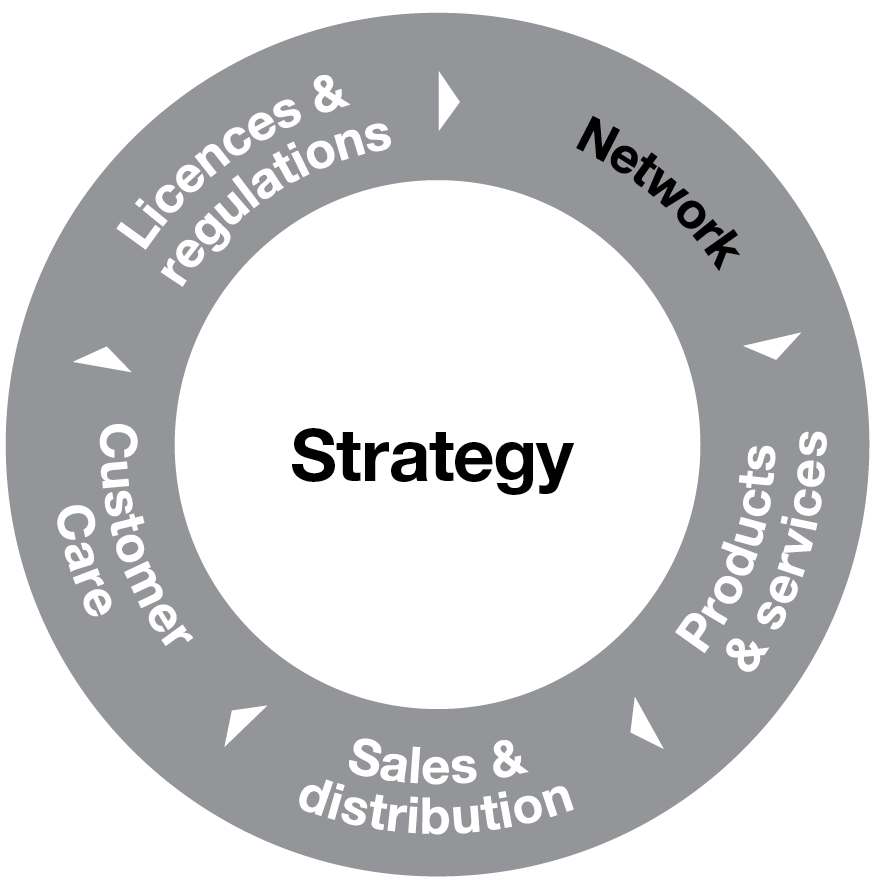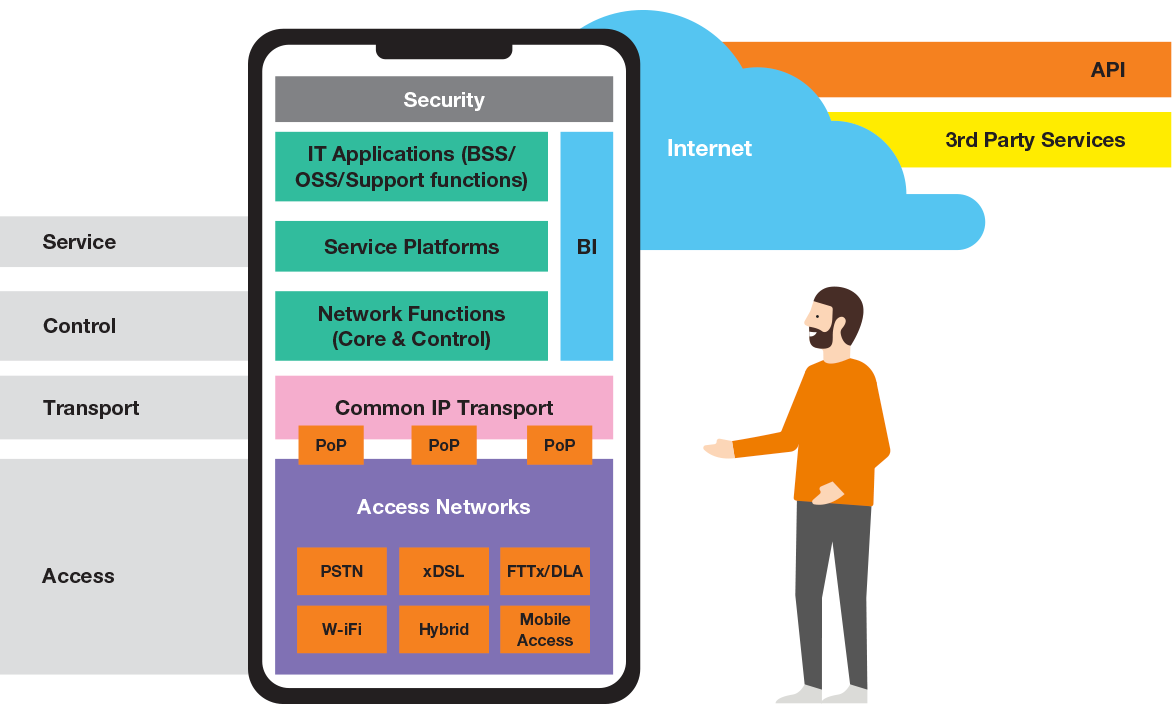
Business model
Network
Network development driven by customer needsOur activities with respect to network development are driven primarily by the needs of our customers. These needs are evolving along with the growing number of mobile devices, as well as the increasing popularity of cloud services, high-resolution videos, games and streaming platforms. In addition, our customers increasingly expect secure access to the digital world, with optimal quality and speed, at home, at work and on the move, regardless of technology and device (laptop, tablet, smartphone, TV). We believe that network reach and connectivity is one of the key criteria when choosing a telecom service provider. To fulfil these needs, our network has to be widely accessible, reliable and safe. We operate by far the largest convergent network infrastructure (combined fixed and mobile networks) in the Polish market. That means we can ensure the best network connectivity.
The largest network infrastructure in Poland
As the former incumbent operator, we have the largest network infrastructure in Poland, supporting both fixed and mobile services. It includes around 15,400 km of fibre in backbone, 91,300 km of fibre in aggregation network and more than 500,000 km of access network. The access network is predominantly built in copper technologies; fibre accounts for around 29,700 km at the moment, although it is growing rapidly in line with our intensive fibre investment plans.
Fibre is also increasingly used to connect our mobile base stations, on one hand to boost capacity to accommodate growing data consumption and on the other hand to ensure greater reliability of the network. At the end of 2018, about 56% of our mobile base stations were connected to the backbone through fibre. Mobile and fixed networks share not only cable infrastructure but also higher network layers like core, control and service platforms. We will gradually transition our network to be fully IP-based in the years ahead, which will require the elimination of certain network elements (e.g. PSTN stacks).
Access network based on technological evolution, local approach and customer demand
To ensure the best connectivity and optimum resource allocation we take into account the specifics of local markets. In cities, we are focusing on the development of Fibre to the Home (FTTH) coverage, whereas in less populous areas, copper-based technologies, supplemented by mobile ones, are the primary broadband access solution. We also roll out our fibre network in smaller towns and in suburban areas on a selective basis. Such a strategy stems from the very individual demand for fibre services in local markets. We are increasingly expanding our fibre network into single-family housing districts, though apartment buildings are still the primary target for our investments.
In the fixed network, we are continuing with an intensive rollout of fibre in line with our medium-term action plan. At the end of 2018, our fibre access network covered almost 3.4 million households in 117 cities and towns. The rate of deployment remains both high and steady, at 0.9 million households and businesses annually.
Over the coming years 5G technology will gain in importance. In 2017, the ‘5G for Poland’ agreement was signed under the aegis of the Minister of Digital Affairs, with Orange Polska as one of its signatories. The Company has been actively involved in the work of various task forces established pursuant to the Agreement. In January 2018, the Ministry of Digital Affairs released a draft ‘5G for Poland’ strategy for public consultation. Based on the outcome of that consultation, a new version of the document is now being prepared. It will set out the tasks and objectives of the public administration with respect to 5G implementation in Poland. The Draft Strategy provides for amending a number of regulations to facilitate quick and efficient deployment of the 5G network. Simultaneously, an update of the National Broadband Plan is being prepared, and its draft incorporates a number of provisions from the draft Strategy. Furthermore, a legislative process to amend the Telecommunication Law was completed in March 2019, addressing radio frequencies management as well as amendments to the telecommunications ‘Mega-Act’ with respect to, inter alia, elimination of red tape for wireless networks.
It is our ambition to actively participate in the implementation of Poland’s 5G network in order to provide our customers with access to this network and modern services based on it. We have continued our preparations for 5G launch. The on-going intensive rollout of our fibre network is a precondition for the efficient operation of the future 5G mobile network. In September and December 2018, we became the first mobile operator in Poland to conduct two-phase tests of the new technology using a base station in Gliwice. The station used a 100 MHz channel from the 3400–3600 MHz band and operated in the Non-Stand Alone (NSA) mode, in which the 4G network is used for connection but data transfer takes place via the 5G network. In 2019, we plan further tests of 5G technology (according to the latest standards) and its practical uses, with equipment provided by various suppliers.
Network reliability and resilience requires the constant upgrade of self-healing network mechanisms and continuous quality monitoring. We are capable of monitoring service quality not only at the statistical level but also from the perspective of an individual customer. We are proactive in our approach and respond before parameters start to deteriorate, preventing network congestion, thus ensuring the same connectivity experience, whether customers use our mobile or fixed networks. The significant increase in security incidents in the on-line economy has led to growing customer interest in cybersecurity services. Therefore, we have set up our Security Operations Centre (SOC), serving Orange Polska and Orange Group affiliates. We have introduced security services for individuals (e.g. Cybershield) and business customers. Orange Polska’s Computer Emergency Response Team (CERT) operates around the clock, taking care of all cybersecurity issues that impact users who access the internet through the Orange Polska network. CERT Orange Polska is also a part of the national cybersecurity ecosystem.
On March 26th 2019, the European Commission recommended
a set of legislative and policy instruments to assess cybersecurity
risk of 5G networks. By the end of June 2019 national risk assessment of 5G network infrastructures should be prepared.
On this basis, Member States should update existing security
requirements for network providers and include conditions
for ensuring the security of public networks, especially when
granting rights of use for radio frequencies in 5G bands. The
national risk assessments and measures should consider various
risk factors, such as technical risks and risks linked to the behaviour of suppliers or operators, including those from third
countries.
Then, on the basis of information obtained from all Member
States and on their own analyses, the Commission together
with ENISA will prepare by October 1st, 2019 a comprehensive
report that identifies all risks on the security of the European
digital sector, in particular the 5G network.
Network efficiency
To increase the efficiency of our infrastructure, legacy technologies and solutions which are mainly voice-oriented are being replaced with a converged network capable of handling all types of traffic: voice, data and video. We implement solutions thatfully support IP technology, and, thanks to self-healing and dynamic reconfiguration mechanisms, provide for higher service quality while improving cost-effectiveness. In our efforts to provide customers with the best network in Poland, we leverage our own investments by using third party infrastructure and benefiting from EU funds for network construction.
On the mobile side, we cooperated with T-Mobile to set up NetWorkS!, a company responsible for network construction and operation. We share sites infrastructure (over 10,000 shared sites), which enabled the fast introduction of 4G and optimisation of operating costs and capital expenditures.
In areas where we are planning to upgrade our network to highspeed, we are also using modern third party infrastructure to supplement our own investments, if a reasonable commercial arrangement can be made. In 2018, we signed further such agreements, which extended coverage of our VHBB services by over 365,000 households.
We participate in the national Operational Programme ’Digital Poland’ (POPC). Between 2014 and 2020, POPC is implementing EU Digital Agenda objectives in Poland and providing EU funds to support network construction in areas where standalone commercial investment is not profitable. That will allow us to upgrade our network to high-speed capabilities in less densely populated areas.
Orange Polska is now carrying out projects won during the
second POPC competition stage. These include the supply of
fast Internet connections (at least 100 Mbps) to 423 districts,
in which about 2,900 schools will also be connected. This
means that, along with the investments that Orange Polska
carries out from its own funds as part of the National Education
Network, in the coming years we will connect optical fibre
to almost 7,400 schools.
Network architecture
